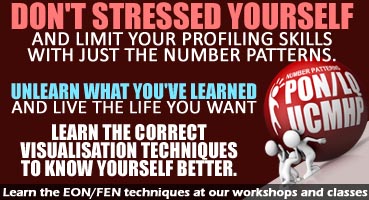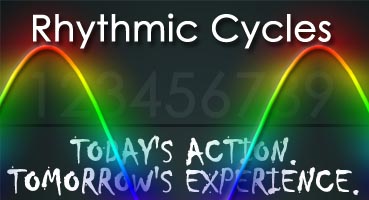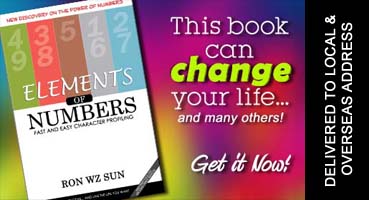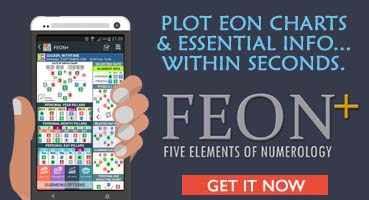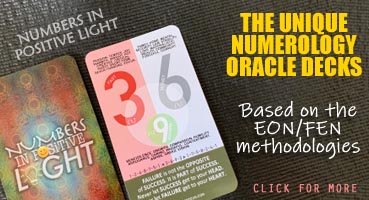EON Bits on Hereditary Locations & More

During one of my FEN (Five Elements Numerology) classes, one student Natasha asked me about the hereditary disease location. She asked after I’d shared with the class on identifying tendency signs of a person who might fall into the “high-risk” group of people having diabetes or with diabetic-like symptoms. Natasha then told the class that according to her previous Visiber trainer, she learned the numbers in the location I-J is where the hereditary signs are identified.
Today’s article is not about disputing the hereditary signs, but establishing an alternative view from the Elements of Numbers (EON) perspective, that allows you to expand the Visiber method and their ‘one side of the coin’ theories beyond the basics. This allows you to unleash the limiting constraints while profiling others, either for free or as a paid service.

I discovered during my research on formulating the Elements of Numbers (EON) method, hereditary health conditions are likely to be identified within the I-O locations, and not necessarily only in the location I-J as in the Visiber method. Here’s a true, real-life analogy – you don’t just associate the head, mental, or cognitive areas for symptoms relating to headache or migraine signs. In Traditional Chinese Medicine (TCM) and Five Elements principles, you can also check other areas, like the stomach (digestive system) too. That signifies, the terrible headache or migraines (the effects) you’re having now, might be caused by poor digestion (the cause).
 When I performed live case study analysis in class, and spotted the probable health sign (using number patterns) within locations I-O, I’d explain the likelihood that the health conditions could be hereditary. Of course, the possibility gauge level of such hereditary signs also depends on where the numbers or patterns (identified as health sign) reside in particular location of an EON chart. In general, when the health sign is on location elsewhere than mentioned, then the likelihood that it’s more of an external-related problem – a result of a lifestyle issue than hereditary ones.
When I performed live case study analysis in class, and spotted the probable health sign (using number patterns) within locations I-O, I’d explain the likelihood that the health conditions could be hereditary. Of course, the possibility gauge level of such hereditary signs also depends on where the numbers or patterns (identified as health sign) reside in particular location of an EON chart. In general, when the health sign is on location elsewhere than mentioned, then the likelihood that it’s more of an external-related problem – a result of a lifestyle issue than hereditary ones.
If you’re a PON, UCMHP, LifeQuest, or Visiber student, just do your homework by profiling as many birth charts as you can. An easier way is to perform an Internet search for celebrities with hereditary health conditions, and see if you can identify the health symptoms ONLY in locations I-J. If there are more cases of health symptoms appearing elsewhere, other than locations I-J, then it means the Visiber method of tying in the I-J location for hereditary disease, is limited. Again, it’s like telling you that “A is for Apple“, and nothing else. That entails, you have invested so much, but just get to learn only the basic levels of profiling.
Frankly, you’d have picked up more on PON, UCMHP, LifeQuest, or Visiber classes than my FEN (Five Elements Numerology) course, because I did not commercially publicise it and charging similar premium course rates. Sadly, many people tend to associate high course fees equate better learning and quality knowledge. My passion is to share my knowledge and understandings on the Elements of Numbers (EON) method, and for those who felt compelled to know the underlying factors, I’d conduct classes when the student quota or quorum is fulfilled.
 By the way, I’d not be initiating any FEN WORKSHOP class on my own for this year, as I’m focusing on life-long, self-enrichment pursuits for Year2020. So, if you want to register for the FEN WORKSHOP class, do me a favour – simply form a group of six like-minded friends who previously attended the PON, UCMHP, LifeQuest, or Visiber course. Once you have formed the 6-pax quota, email me, and I can schedule a class. This way, I can optimise the “flow energies” by sharing more exciting new techniques, visualisation profiling, and practical behavioural change methods that you can use to help yourself and others!
By the way, I’d not be initiating any FEN WORKSHOP class on my own for this year, as I’m focusing on life-long, self-enrichment pursuits for Year2020. So, if you want to register for the FEN WORKSHOP class, do me a favour – simply form a group of six like-minded friends who previously attended the PON, UCMHP, LifeQuest, or Visiber course. Once you have formed the 6-pax quota, email me, and I can schedule a class. This way, I can optimise the “flow energies” by sharing more exciting new techniques, visualisation profiling, and practical behavioural change methods that you can use to help yourself and others!
During lunch breaks, Natasha told me she learned in her Visiber class that M-N-O represents the INTROVERT sign, and S-T-R represents the EXTROVERT sign. Oh, by the way, let’s pause for a second as I need to clarify – the S-T-R locations stated earlier is based on Visiber charting layout. From the EON chart layout, it’s the locations U-X-R.
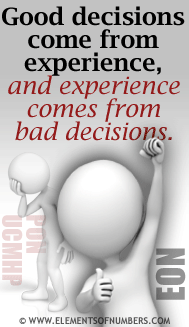 In Visiber method, the locations U-X-R of an EON Chart could only be 3 (representing Idealist), 6 (Realist), or 9 (Visionary); and these are the unique areas to identify an extroverted behavioural sign. If you’ve read my recent article “Extrovert and Introvert Numbers”, you’d have read about me explaining the reasons that a person’s behaviour can be either extroversion or introversion, depending on their responses to a situation. This implies, an idealist person with number 3 can behave like a wild and joyful person (as in extrovert trait) and a quiet, centred, and passionate person who disliked attention until the problem is solved (as in introvert trait). Similarly, a person with number 6 in locations U-X-R (on EON chart) can be a “Realist” person who enjoys spending time internally at home with his or her family (introvert) than lavishly spending money externally on social activities (extrovert). The point is, if you’re a student attending these external classes, you’re not receiving the whole picture of human behavioural profiling. Instead, you’ve just received a few pieces of the jigsaw puzzle, and yes, a costly one that included limiting knowledge.
In Visiber method, the locations U-X-R of an EON Chart could only be 3 (representing Idealist), 6 (Realist), or 9 (Visionary); and these are the unique areas to identify an extroverted behavioural sign. If you’ve read my recent article “Extrovert and Introvert Numbers”, you’d have read about me explaining the reasons that a person’s behaviour can be either extroversion or introversion, depending on their responses to a situation. This implies, an idealist person with number 3 can behave like a wild and joyful person (as in extrovert trait) and a quiet, centred, and passionate person who disliked attention until the problem is solved (as in introvert trait). Similarly, a person with number 6 in locations U-X-R (on EON chart) can be a “Realist” person who enjoys spending time internally at home with his or her family (introvert) than lavishly spending money externally on social activities (extrovert). The point is, if you’re a student attending these external classes, you’re not receiving the whole picture of human behavioural profiling. Instead, you’ve just received a few pieces of the jigsaw puzzle, and yes, a costly one that included limiting knowledge.
Let’s put aside my explanations and check out the Dictionary.com for more info on the followings:
- Idealist: A person who cherishes or pursues high or noble principles, purposes, goals, etc.
- Realist: A person who tends to view or represent things as they really are.
- Visionaries: A person of unusually keen foresight; a person who is given to audacious, highly speculative, or impractical ideas or schemes; dreamer.
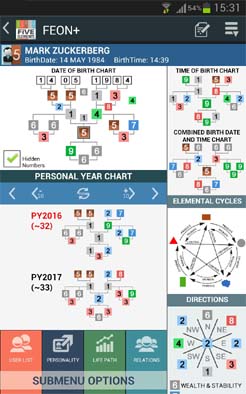 The above three categories of people, which in Visiber method, relates to the numbers 3, 6, or 9; can demonstrate both extrovert and introvert behaviours. Plot the EON charts of Steve Jobs, Whitney Houston, Elon Musk, Bill Clinton, Mark Zuckerberg, Li Ka-shing, Steve Wozniak, Donald Trump, and/or anyone you recognise – I believe you can identify them easily as a person with mood-swinging characteristics, showing both extrovert and introvert traits as well, at different stages of their lives, and at various periods in time. In Mark Zuckerberg’s case, he has no number 9 (Visionary) in the U-X-R of his EON chart (screenshot on left).
The above three categories of people, which in Visiber method, relates to the numbers 3, 6, or 9; can demonstrate both extrovert and introvert behaviours. Plot the EON charts of Steve Jobs, Whitney Houston, Elon Musk, Bill Clinton, Mark Zuckerberg, Li Ka-shing, Steve Wozniak, Donald Trump, and/or anyone you recognise – I believe you can identify them easily as a person with mood-swinging characteristics, showing both extrovert and introvert traits as well, at different stages of their lives, and at various periods in time. In Mark Zuckerberg’s case, he has no number 9 (Visionary) in the U-X-R of his EON chart (screenshot on left).
If you’ve knowledge in other behavioural profiling models, like Myers-Briggs Type Indicator (MBTI), or Enneagram, you’d noticed that an individual’s personalities are based on their answers to the multiple-choice questionnaires (MCQ). This implies, the state of our mind at the time of filling up the MCQ test, like “I think I am a good communicator,” could contradict their answers when it’s done again, after a period of time, like six months later. That is why when you do an Internet search for Steve Jobs, there are debates on his MBTI personality types – from ENTJ, ISTP, INTJ, ENTP, and so on.
 What does this means, for HR professionals and anyone relying on MBTI on profiling potential employees’s personalities? Oh, perhaps I can post a separate article on that…
What does this means, for HR professionals and anyone relying on MBTI on profiling potential employees’s personalities? Oh, perhaps I can post a separate article on that…
The point is, a person’s behaviours and actions towards similar situation at different times, could lead to different outcomes. For instance, when I plotted the late Steve Jobs’ EON Birth chart, there is no number 9 in U-X-R locations. Does this imply – from Visiber method, we can conclude that Steve Jobs is not a visionary, and he’s definitely either an Idealist or Realist instead? Steve Jobs, if you know him personally, or have read his biography book, was a person who exhibited both the extrovert and introvert traits. He, like every one of you, could change your behavioural styles, anytime depending on your conscious mind and your responses or reactions to an issue, problem, or situation.
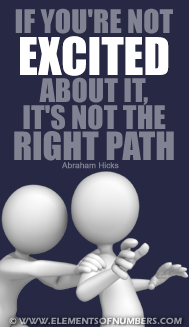 Visiber method of identifying hereditary disease in locations I-J; and their approach of identifying extroverts and introverts, are not wrong as these are based on their knowledge, understanding, and observations. It’s limited…
Visiber method of identifying hereditary disease in locations I-J; and their approach of identifying extroverts and introverts, are not wrong as these are based on their knowledge, understanding, and observations. It’s limited…
When it comes to profiling someone on a paid basis, or training students to be future profiling professionals, relying on these preliminary theories alone is insufficient to equip yourself to handle the real-world situations. Every individual cannot be permanently grouped into 16-personality types (as in MBTI), nine types (as in Enneagrams), and four types (as in DiSC). Similarly, it is difficult for you to exert the confidence level, to be the competent and knowledgeable person, who can profile, and conclude that the locations S-T-R (from Visible Chart layout) is all about extrovert signs, and M-N-O as introvert signs. That’s too preliminary, like telling adults that we can only remember and correlate the letter “A is for Apple” , and nothing else.
Be practical, sensible, and excited. When certain theories are inconclusive and limiting, do not waste the time and effort in asserting them to be correct or accurate. People are smarter these days, and can easily spot your profiling weakness and “only the tip of the iceberg” knowledge. Stop the embarrassment. Spend the time on more insightful ones, like reading more of my articles on this site, and investing the knowledge-building by attending my classes.
Happy learning…
Regards, Ron WZ Sun



